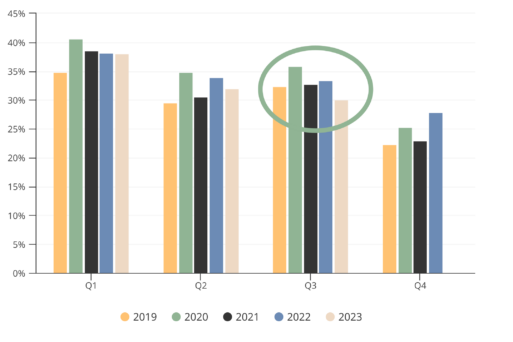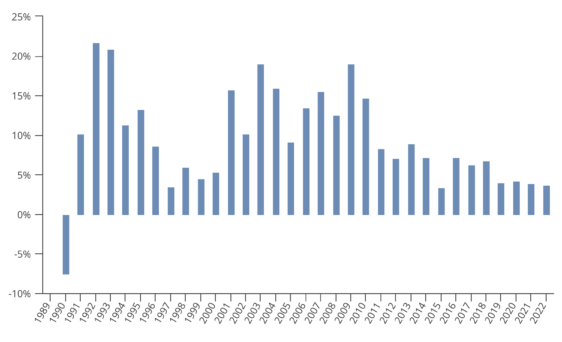- November 21, 2023 Economy
Is China Returning to Export Dependence? Not Really
As the Chinese economy sputters, debate around China’s massive surplus has heated up again. Alarmists argue that with investment down and consumer demand lackluster, Beijing has little choice but to resort to export-led growth, flooding the world with Chinese goods. But their fear of China running ever larger current account surpluses is likely misplaced.
While it’s true that China registered some of its biggest trade surpluses in recent years, that was likely a one-time, pandemic effect on which China capitalized to expand exports. We believe that rather than continuing indefinitely, China’s current account surplus has largely peaked. In fact, there’s no real possibility that China will return to a world in which it is running a current account surplus north of 10% of GDP, like it did before the Global Financial Crisis.
Below are factors and secular trends that militate against China returning to its export-dependent days.
1. Large surpluses are a pandemic blip not a secular trend
Like many tech stock prices, China’s unusually large surpluses were also a pandemic phenomenon. While advanced economies struggled with significant producer inflation, China saw deflation and currency depreciation of about 10%. These factors made Chinese goods about 30% cheaper relative to US goods, which essentially cancelled out the effect of the Trump tariffs. Moreover, global demand also shifted from services to goods during the pandemic, further benefitting Chinese exports.
Now that inflation is cooling globally, and with China seemingly defending its currency, Chinese goods’ price advantage is being eroded. As a result, China’s surplus as a percentage of GDP has been declining since the end of the pandemic (see Figure 1).
Figure 1. China’s Surplus Falling Back To Earth

Source: NBS and MacroPolo.
Despite the pandemic effect, one may wonder what’s to prevent China’s surplus from returning to its previous heights in coming years? Here secular trends in Chinese household savings and overall investment do not bode well for running ever larger surpluses. That’s because the current account surplus is simply a function of changes in savings and investment. If a country’s savings go up or investment goes down or both, that can lead to higher surpluses.
For China, the most likely outcome is that both the savings and investment rate will fall at roughly the same pace, with the former declining a bit faster. Under these conditions, it is highly improbable to see continued increases in the surplus. Let’s take a brief look at the drivers of savings and investment to see why this is the case.
2. Chinese savings are in gradual, long-term decline
A nation’s aggregate savings is typically composed of three parts: households, corporates, and government. A decent gauge of consumption trends is to look at shifts in household savings. Despite much being made about Chinese households not spending their savings post-Zero Covid, the macro picture shows that household savings hardly rose during the pandemic. In fact, the savings rate has started declining, reaching 2019’s level in 3Q2023 (see Figure 2).
Figure 2. China’s Household Savings Rate Has Declined to Pre-Pandemic Levels

Note: We only look at households here because we assume the government and state sector will continue to spend beyond their means, or run deficits, rather than save.
Source: NBS and MacroPolo.
And there is indeed good reason to believe that the household savings rate will continue to decline. This is what one would expect of savings rates in a rapidly aging society like China’s, as the rise and decline of savings tend to follow life cycle patterns. That is, the young don’t have much money to save and the old spend down their savings, while savings peak during the period of one’s working life.
3. Investment has likely already hit bottom
When it comes to investment, it is probably about as bad as it’s going to get. While investment growth isn’t going to roar back any time soon, it is also very difficult to imagine it entering negative territory. Even throughout China’s property sector correction of the last couple years, investment was growing above 3% in 2021 and 2022. So too will investment weather the coming local debt deleveraging process in the sense that it probably won’t affect investment any more than the property sector correction did.
In fact, China’s investment has grown consecutively for more than three decades (see Figure 3). The closest investment came to contraction was in 2015—the period of China’s currency volatility, capital outflows, and severe overcapacity, during which global trade also contracted by more than 10%.
Figure 3. Investment Growth More Resilient Than Assumed

Source: NBS and MacroPolo.
As the world’s largest exporter—about $3.5 trillion—China’s export composition is very complex and rising in value. So it is entirely possible for China to “flood” the global market with a very small subset of exports, for instance batteries, while also having its overall current account surplus stay flat. Secular trends strongly suggest that China’s best export days are already behind it.
Stay Updated with MacroPolo
Get on our mailing list to keep up with our analysis and new products.
Subscribe
